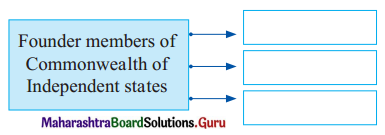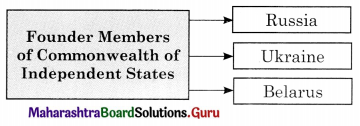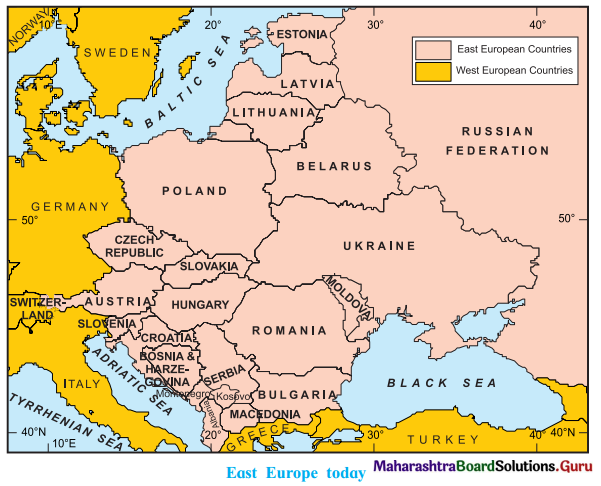Balbharti Maharashtra State Board Class 11 Political Science Solutions Chapter 10 The World Since 1945 – II Textbook Exercise Questions and Answers.
Maharashtra State Board Class 11 Political Science Solutions Chapter 10 The World Since 1945 – II
1A. Choose the correct alternative and complete the following statements.
Question 1.
The __________ Missile Crisis took place in 1962. (American, Cuban, Russian, Chinese)
Answer:
Cuban
![]()
Question 2.
In 1978, the United States held a conference at __________ to resolve the Arab-Israel dispute. (Camp David, Helsinki, Paris, Geneva)
Answer:
Camp David
1B. Identify the incorrect pair in every set, correct it and rewrite.
Question 1.
(a) Iran – Ayatollah Khomeini
(b) Afghanistan – Babrak Karmal
(c) Soviet Union – Richard Nixon
Answer:
(c) USA – Richard Nixon
1C. State the appropriate concept for the given statement.
Question 1.
Prohibiting ships from entering the port of a country.
Answer:
Naval Blockade
![]()
Question 2.
Reconstruction of the political and economic system was established in the Soviet Union.
Answer:
Perestroika
2A. Complete the concept map.
Question 1.

Answer:

2B. Observe the given map and answer the following questions.
Question 1.
Map of East Europe today.

Question i.
Name any 4 countries formed after the disintegration of the Soviet Union.
Answer:
Russia, Ukraine, Belarus, Armenia, Georgia Latvia, Estonia, Moldova, Lithuania, Azerbaijan.
![]()
Question ii.
Name two neighbouring countries of Hungary.
Answer:
Austria, Croatia, Serbia, Romania, Slovakia.
3. State whether the following statements are true or false with reasons.
Question 1.
Non-aligned countries put forth the demand for NAFTA.
Answer:
This statement is False.
- North American Free Trade Agreement (NAFTA) was set up as a ‘trade bloc’ in January 1994.
- It was signed between the USA, Canada, and Mexico to encourage free trade between the three North American Nations (trilateral trade bloc).
Question 2.
Pandit Jawaharlal Nehru was the founder of ASEAN.
Answer:
This statement is False.
- Association of South-East Asian Nations was established in 1967 by the Bangkok declaration.
- Pandit Jawaharlal Nehru was one of the founders of the Non-Aligned Movement in 1961 at Belgrade.
4. Explain the co-relation between the following.
Question 1.
Cold War and Non-aligned movement.
Answer:
The Cold War began after the end of the Second World War in 1945. It refers to a period of intense ideological hostility, build-up of armaments, the establishment of military alliances e.g., NATO, WARSAW Pact, etc., and even proxy wars such as in Korea and Vietnam. There were many efforts from 1945 – 1991 on the part of both superpowers to bring about detente i.e., reduction of hostilities and tensions e.g., Moscow Summit (1972). However, for most of this period, the world was divided into the Capitalist bloc (led by the USA and including England, France, etc.) and Communist bloc (led by USSR and including East European nations).
There were a number of newly independent countries as well as some other Third World countries who did not want to join the military alliances of any power bloc. Through the initiative of Jawaharlal Nehru (India) and Marshall Tito (Yugoslavia), the NAM was formally established in 1961 at Belgrade. Other member countries included Ghana, Egypt, Sri Lanka. Indonesia, etc. Non-alignment is based on two main principles:
- independent understanding of world affairs
- peace approach.
It does not mean political neutrality or passivity but active participation in world affairs without joining any power bloc or military alliance.
![]()
5. Answer the following.
Question 1.
Explain the term – New Cold War.
Answer:
Two events that occurred in 1979 change the course of detente.
- Islamic Revolution in Iran under leader Ayatollah Khomeini overthrew the rule of M.R. Shah Pahlavi. The new government withdrew from the CENTO alliance.
- The Soviet Union invaded Afghanistan in 1979 and installed Babrak Karmal as the President. The insurgent groups in Afghanistan (mujahideen) fought against this government (1979 – 1989). The new Cold War refers to the end of the period of detente and return of tensions between the USA and the USSR.
Question 2.
What is a trade bloc?
Answer:
A trade bloc is created when a group of nations makes special agreements regarding their economic relationships with each other. The agreements generally focus on the relaxation or even elimination of trade barriers. The most common types of trade barriers are tariffs (taxes on imports) and quotas (limits on the quantities of various imports).
6. Express your opinion on the following.
Question 1.
India played an important role in the Cold War.
Answer:
India was a non-aligned member during the cold war. It means India was neither on the side of the USA nor the Soviet Union. This was for official purposes, which enabled us to avoid giving away our land or resources to the Soviets or Americans (which they could use as a military base and eventually also make India their vassal). Having said that, unofficially India fully supported the Soviet Union.
Soviet Union protected India from the onslaught of the USA, during the India Pakistan war of 1971. The indo-soviet pact during 1971 was spearheaded by PM Indira Gandhi. Further, India cooperated and collaborated greatly with the Soviet Union in the fields of defense, manufacturing industries, medicine, nuclear energy, science among others, however, India was never a direct party to the cold war standoff between the USA and the Soviet Union.
7. Answer the following in detail with reference to the given points.
Question 1.
Elaborate on the period of Detente.
(a) Meaning
(b) Initiatives are taken by superpowers to reduce tensions
Answer:
(a) Meaning of detente: Detente refers to efforts to bring about a reduction in tensions between the USA and the USSR. This was an attempt by the two ‘superpowers’ themselves. The Cuban Missile Crises brought in a realization of a possible nuclear confrontation and the need to deescalate the tensions.
![]()
(b) Initiatives taken by the superpowers to reduce tensions: After the Cuban Missile Crisis, both the USA and USSR made several efforts at reducing bilateral tensions (detente).
This included:
- a hotline was set up between the main leaders of the two nations
- the signing of agreements such as NNPT, LTBT to reduce nuclear weapons
- 1972, Moscow Summit between President Nixon (USA) and Brezhnev (USSR).
Other initiatives were-
- Conference at Paris (1973) to bring the Vietnam crisis to an end.
- Helsinki conference on security in Europe (1975) was attended by 35 nations including the USA and USSR. It aimed to reduce the tensions between eastern and western European countries.
- The first joint US-Soviet space flight was the Apollo-Soyuz Test Project (1975)
- The USA held a conference at Camp David in 1978 to resolve the long-pending Arab-Israel dispute. The ‘Framework for Peace in the Middle East was signed between President Carter (USA) President Sadat (Egypt) and Prime Minister Begin (Israel).
Find out! (Text Book Page No. 86)
Can you find out some of the summit meetings that have taken place between leaders of India and Pakistan in recent years? Who were the leaders who participated and when and where did the meetings take place?
Answer:
- The Delhi Pact (Liaquat-Nehru Pact) was signed on 8th April 1950 as a bilateral treaty between India and Pakistan. It was signed in New Delhi by the then Indian, Prime Minister Jawaharlal Nehru and Pakistan, Prime Minister Liaquat Ali Khan.
- Tashkent Declaration (10th January 1966) was a peace agreement after the 1965 Indo-Pakistan war signed between Mohammed Ayub Khan (President of Pakistan) and Lai Bahadur Shastri (Prime Minister of India) in Tashkent.
- Shimla Agreement was signed on 2nd September 1972 after the 1971 Indo-Pakistan war. Signatories were Indian Prime Minister Mrs. Indira Gandhi and Pakistan Prime Minister Zulfikar Ali Bhutto.
- The non-Nuclear Aggression Agreement was signed on 21st December 1988 in is Islamabad by Rajiv Gandhi (Prime Minister of India) and Benazir Bhutto (Prime Minister of Pakistan).
- Lahore Agreement – Signed on 21st February 1999. Signatories were Shri. Atal Bihari Vajpayee (India) and Nawaz Sharif (Pakistan).
- Agra Agreement (2001). The Negotiators were Shri. Vajpayee and Pervez Musharaf (Pakistan) but negotiators broke down.
![]()
Activity (Text Book Page No. 92)
Make a list of all summit meetings of SAARC.
Answer:
| Summit year | Place |
| 1st – 1985 | Dhaka (Bangladesh) |
| 2nd – 1986 | Bangalore (India) |
| 3rd – 1987 | Kathmandu (Nepal) |
| 4th – 1988 | Islamabad (Pakistan) |
| 5th – 1990 | Male (Maldives) |
| 6th – 1991 | Colombo (Sri Lanka) |
| 7th – 1993 | Dhaka (Bangladesh) |
| 8th – 1995 | New Delhi (India) |
| 9th – 1997 | Male (Maldives) |
| 10th – 1998 | Colombo (Sri Lanka) |
| 11th – 2002 | Kathmandu (Nepal) |
| 12th – 2004 | Islamabad (Pakistan) |
| 13th – 2005 | Dhaka (Bangladesh) |
| 14th – 2007 | New Delhi (India) |
| 15th – 2008 | Colombo (Sri Lanka) |
| 16th – 2010 | Thimphu (Bhutan) |
| 17th – 2011 | Addu City (Maldives) |
| 18th – 2014 | Kathmandu (Nepal) |
| 19th – 2016 | Islamabad (Pakistan) (event canceled) |